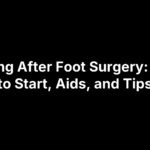Advanced surgical services for foot and ankle means specialized care that goes beyond standard treatments. These services include complex procedures like joint reconstruction, tendon repair, minimally invasive surgery, and limb salvage. You get access to modern surgical technology, experienced specialists, and comprehensive support from your initial consultation through complete recovery. The advanced part refers to both the technical skill required and the sophisticated equipment used during these procedures. Think of it as the difference between routine care and specialized intervention for conditions that need expert attention.
This guide helps you understand what makes surgical care truly advanced and how to find the right surgeon for your specific condition. You’ll learn about common procedures, preparation steps, recovery timelines, and where to access quality care in Central Virginia. Whether you’re dealing with chronic pain that hasn’t responded to conservative treatment, recovering from sports injuries, or considering reconstructive surgery, you’ll discover what questions to ask your surgeon and how to make informed decisions about your treatment options.
Why advanced surgical services matter for foot and ankle
Your feet and ankles carry your entire body weight every single day, absorbing impact with each step you take. When chronic conditions or severe injuries affect these structures, standard treatments like physical therapy, medication, or basic orthotics sometimes fail to provide lasting relief. Advanced surgical services become necessary when conservative approaches can’t restore your mobility, reduce your pain, or prevent further damage to the affected area. These specialized procedures address the root cause of your problem rather than temporarily masking symptoms.
When conservative treatment isn’t enough
You might spend months trying injections, braces, and physical therapy protocols only to find yourself still unable to walk without pain or participate in activities you enjoy. Conservative treatments work well for many foot and ankle conditions, but some problems require surgical correction to heal properly. Severe ligament tears, advanced arthritis, complex fractures, and progressive deformities often need surgical intervention to prevent permanent disability. Your body has natural healing limits, and certain structural damage simply won’t repair itself through rest and rehabilitation alone.
Advanced surgical intervention becomes your best option when conservative care fails to restore function or prevent progressive deterioration.
The cost of delaying surgical intervention
Putting off necessary surgery leads to worsening pain and reduced mobility that affects your entire quality of life. You compensate for foot and ankle problems by changing how you walk, which creates new issues in your knees, hips, and lower back. Delayed treatment also allows conditions like diabetic ulcers or chronic wounds to progress, increasing your risk of serious infections or even amputation. The longer you wait, the more complex your eventual surgery becomes, often requiring more extensive procedures and longer recovery periods. Early intervention through advanced surgical services typically results in better outcomes, faster healing, and fewer complications than waiting until your condition becomes severe.
How to choose the right advanced foot and ankle surgeon
Finding the right surgeon determines your surgical outcome just as much as the procedure itself. You need someone who specializes specifically in foot and ankle surgery, not a general orthopedic surgeon who occasionally performs these procedures. Board certification in podiatric surgery or orthopedic surgery with foot and ankle fellowship training ensures your surgeon has completed rigorous education and testing in this specialized field. Your choice impacts everything from surgical precision to complication rates to how well your foot or ankle functions after you heal.
Credentials and specialized training you should verify
Your surgeon’s qualifications go beyond their medical degree. Look for board certification from recognized organizations like the American Board of Foot and Ankle Surgery or the American Board of Orthopaedic Surgery with subspecialty certification. These credentials prove your surgeon meets strict standards for knowledge, skill, and ongoing education in their field. Fellowship training in foot and ankle surgery adds another layer of expertise, showing your surgeon completed additional years of specialized training beyond their residency program. You can verify these credentials through state medical boards and professional organization websites.
Questions to ask during your initial consultation
Start by asking how many times your surgeon has performed the specific procedure you need and what their complication rates are. Experience with your exact condition matters significantly because foot and ankle anatomy involves complex relationships between bones, tendons, ligaments, and nerves. Ask about alternative treatment options and why surgery represents your best path forward at this point. Request information about expected recovery timelines, pain management approaches, and potential risks specific to your situation. A skilled surgeon welcomes these questions and provides clear, honest answers without pressuring you toward unnecessary procedures.
The right surgeon explains complex medical information in ways you understand and involves you fully in treatment decisions.
Evaluating surgical experience and outcomes
You deserve to know how patients with similar conditions have fared after surgery with this particular surgeon. Request outcome data for procedures like yours, including success rates and patient satisfaction scores. Access to advanced surgical services means your surgeon uses modern techniques like minimally invasive approaches when appropriate, reducing your recovery time and surgical trauma. Check whether they operate at accredited surgical facilities with proper safety protocols and emergency equipment. Read patient reviews while recognizing that one or two negative experiences don’t necessarily reflect overall quality, but patterns of complaints about communication, outcomes, or follow-up care signal potential problems.
Advanced foot and ankle procedures explained
Advanced surgical services for foot and ankle encompass a wide range of procedures, from simple outpatient operations to complex reconstructive surgeries that require extensive planning and recovery time. Your specific procedure depends on your diagnosis, the severity of your condition, and how your body has responded to previous treatments. Understanding what each type of surgery involves helps you prepare mentally and physically for your procedure while setting realistic expectations about your recovery timeline and final outcome. Some procedures address structural problems you were born with, while others repair damage from injuries or progressive conditions like arthritis.
Reconstructive and corrective surgeries
Bunion surgery corrects the misalignment of your big toe joint, which causes that painful bump on the side of your foot. Your surgeon removes excess bone, realigns your toe, and may insert screws or plates to hold everything in the correct position while you heal. The procedure involves cutting bone (called an osteotomy), repositioning the joint, and sometimes releasing tight ligaments that pull your toe out of alignment. You’ll need several weeks of limited weight-bearing after surgery, often using a surgical boot or crutches to protect the repair site.
Hammertoe correction addresses those bent, contracted toes that rub against your shoes and create painful calluses. Your surgeon releases tight tendons, removes small sections of bone if needed, and uses pins or screws to hold your toe straight during healing. Flatfoot reconstruction represents a more complex procedure that rebuilds your arch through tendon transfers, bone cuts, and sometimes fusion of certain joints. These structural corrections require precise surgical technique because your surgeon must restore proper alignment while maintaining your ability to walk naturally. Recovery from reconstructive procedures typically takes three to six months before you return to full activity levels.
Minimally invasive procedures
Arthroscopic surgery allows your surgeon to diagnose and treat problems inside your ankle joint through tiny incisions rather than opening the joint completely. Small cameras and specialized instruments enter through portals the size of pencil tips, giving your surgeon a magnified view of cartilage damage, loose bodies, or scar tissue that needs removal. You experience less tissue trauma, reduced scarring, and faster recovery compared to traditional open surgery. Arthroscopy works well for conditions like ankle impingement, cartilage injuries, and synovitis that cause swelling and pain inside your joint.
Percutaneous procedures take minimally invasive surgery even further by performing certain corrections through puncture holes rather than standard incisions. Your surgeon uses fluoroscopy (real-time X-ray imaging) to guide tiny burrs and instruments that shave down bone spurs, release tight tendons, or correct minor deformities. These techniques significantly reduce your recovery time because they preserve surrounding tissues and minimize surgical trauma. However, not every condition suits minimally invasive approaches, and your surgeon must balance technique advantages against the need for adequate surgical exposure to achieve lasting correction.
Minimally invasive procedures reduce recovery time and surgical trauma, but your surgeon determines the best approach based on your specific condition and anatomy.
Complex trauma and limb salvage procedures
Severe fractures often require open reduction and internal fixation, where your surgeon realigns broken bones and secures them with plates, screws, or rods. Ankle fractures involving multiple bones or damage to your ligaments need precise reconstruction to restore joint stability and prevent arthritis. Your surgeon may need to repair torn ligaments, reconstruct damaged cartilage, or fuse certain joints if the injury destroyed critical structures. Complex fractures sometimes require staged procedures, where your surgeon first stabilizes the area with external fixation, then performs definitive repair once swelling decreases and soft tissues recover.
Advanced wound care and limb salvage procedures save feet and ankles that face potential amputation from severe infections, diabetic ulcers, or compromised blood flow. These surgeries remove infected or dead tissue, restore blood supply through vascular procedures, and use skin grafts or flaps to cover exposed bone and tendons. Limb salvage requires coordination between multiple specialists and often involves several staged procedures over weeks or months. Your surgeon balances the realistic potential for healing against the risks of ongoing infection and the functional outcome you can expect compared to amputation with a prosthetic device. These complex procedures represent the pinnacle of advanced surgical services, requiring exceptional skill and judgment to achieve successful outcomes.
Preparing for and recovering from surgery
Your surgical outcome depends heavily on how well you prepare beforehand and follow recovery protocols afterward. Proper preparation reduces your risk of complications, speeds your healing, and helps you return to normal activities more quickly. Recovery from foot and ankle surgery requires patience because these structures bear your entire body weight during daily activities. Understanding what happens at each stage of the process helps you set realistic expectations and recognize when something needs medical attention rather than representing normal healing progress.
Pre-surgery preparation steps
Your surgeon provides specific instructions about stopping certain medications, fasting before surgery, and arranging transportation home from the surgical center. Blood thinners, anti-inflammatory drugs, and some supplements increase bleeding risk, so you must discontinue them according to your surgeon’s timeline. Schedule time off work based on your procedure type and job requirements, typically two weeks minimum for desk jobs and six to twelve weeks for physical labor. Prepare your home by creating a recovery space on your main floor with easy access to bathrooms, placing items you need daily within reach, and removing tripping hazards like loose rugs or clutter.
Stock your refrigerator with easy-to-prepare meals and plenty of water before surgery because moving around on crutches or in a surgical boot makes cooking difficult. Arrange for someone to stay with you for at least the first 24 to 48 hours after surgery to help with basic tasks and monitor for complications. Fill your prescriptions ahead of time so pain medication is ready when you return home. Purchase any medical supplies your surgeon recommends, such as ice packs, extra pillows for elevation, and wound care materials that help you follow post-operative instructions properly.
What to expect during recovery
Your first two weeks focus on protecting the surgical site, managing pain, and reducing swelling through elevation and ice application. You’ll keep weight off your operated foot using crutches, a knee scooter, or a surgical boot depending on your procedure. Swelling peaks around days three to five, then gradually decreases if you follow elevation guidelines and ice regularly. Follow-up appointments let your surgeon check your incision, remove sutures if needed, and adjust your weight-bearing status based on healing progress shown on X-rays or physical examination.
Recovery timelines for advanced surgical services vary significantly based on procedure complexity and your individual healing capacity. Simple procedures like arthroscopy may allow full weight-bearing within weeks, while reconstructive surgeries require six to twelve weeks of protected healing before you resume normal activities. Physical therapy typically starts once your surgeon confirms adequate bone healing and wound closure. Therapists guide you through exercises that restore strength, flexibility, and proper walking mechanics without stressing your repair before it’s ready. Most patients return to low-impact activities around three months post-surgery and high-impact sports or heavy labor between six and twelve months.
Your commitment to following post-operative protocols directly determines how well your foot or ankle functions after complete healing.
Managing pain and preventing complications
Pain management combines prescription medication for the first several days with over-the-counter options as discomfort decreases. Your surgeon balances effective pain control against the risks of opioid dependence, often using non-narcotic alternatives when possible. Ice application and elevation reduce both pain and swelling more effectively than medication alone. Watch for warning signs that require immediate medical attention: increasing pain that doesn’t respond to medication, fever above 101°F, red streaks spreading from your incision, or drainage with foul odor. These symptoms may indicate infection or other complications that need prompt treatment to prevent serious problems.
Blood clots represent another potential complication after foot and ankle surgery, especially if you remain immobile for extended periods. Your surgeon may prescribe blood thinners or compression devices depending on your risk factors. Prevent clots by performing ankle pumps and toe wiggling exercises throughout the day, even while resting. Nerve pain or numbness that worsens rather than improves over time needs evaluation because excessive swelling or tight dressings can compress nerves and cause permanent damage if not addressed quickly.
Finding care in Central Virginia
Central Virginia offers several options for specialized foot and ankle surgery, but the quality of care varies significantly between providers. You want a practice that combines experienced surgeons, modern surgical facilities, and comprehensive support throughout your treatment journey. Location convenience matters because you’ll need multiple follow-up appointments during your recovery period, making it impractical to travel long distances while managing limited mobility. The right provider operates accredited surgical centers close to your home and accepts your insurance plan to reduce financial barriers to necessary care.
Identifying quality surgical centers in your area
Your local surgical center should meet specific accreditation standards that ensure patient safety and proper equipment maintenance. Look for facilities certified by organizations that regularly inspect operating rooms, sterilization processes, and emergency protocols. Advanced surgical services require specialized equipment like fluoroscopy machines, arthroscopic towers, and proper anesthesia monitoring systems that not all surgical centers maintain. Ask whether the facility performs your specific procedure regularly, as surgical teams that work together frequently achieve better outcomes and fewer complications than those performing occasional surgeries.
Choosing a provider with multiple locations across Central Virginia gives you flexibility for appointments and access to specialized care close to home.
Insurance coverage and scheduling considerations
Verify that your chosen surgeon accepts your insurance plan before scheduling consultations, as out-of-network providers significantly increase your costs. Most advanced surgical services qualify for coverage under medical insurance rather than requiring separate surgical plans. Request same-day or urgent appointments when you need quick evaluation of worsening symptoms or new injuries that might require surgical intervention.
Next steps for your foot and ankle care
Taking action on persistent foot and ankle problems starts with scheduling a consultation with qualified specialists who can evaluate your condition and recommend appropriate treatment options. You’ve learned how advanced surgical services provide solutions when conservative care fails, what credentials matter in choosing a surgeon, and how proper preparation affects your recovery outcomes. Your next move involves contacting a specialized practice that offers comprehensive care from initial diagnosis through complete healing and rehabilitation. Waiting for symptoms to improve on their own typically leads to worsening conditions that become more difficult and costly to treat.
Achilles Foot and Ankle Center serves Central Virginia with thirteen convenient locations and operates the region’s only Foot and Ankle Ambulatory Surgery Center. Their board-certified specialists provide same-day appointments for urgent concerns, accept all major insurance plans including Medicare and Medicaid, and offer both conservative treatments and advanced surgical options tailored to your specific needs. The practice combines state-of-the-art technology with experienced surgeons who perform procedures ranging from minimally invasive arthroscopy to complex reconstructive surgery. Schedule your consultation today to stop living with pain and get back to the activities you enjoy.






